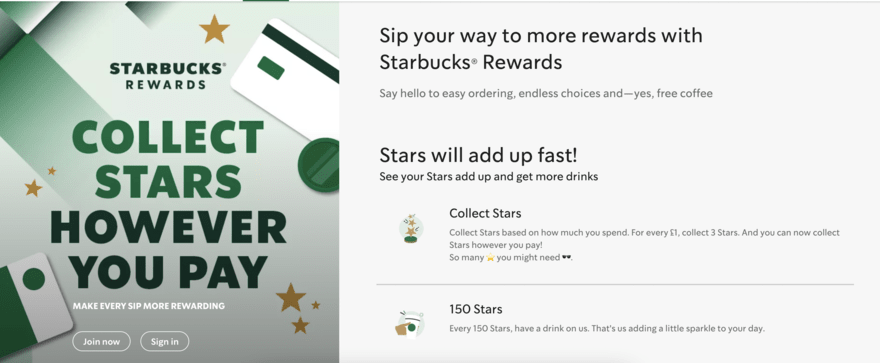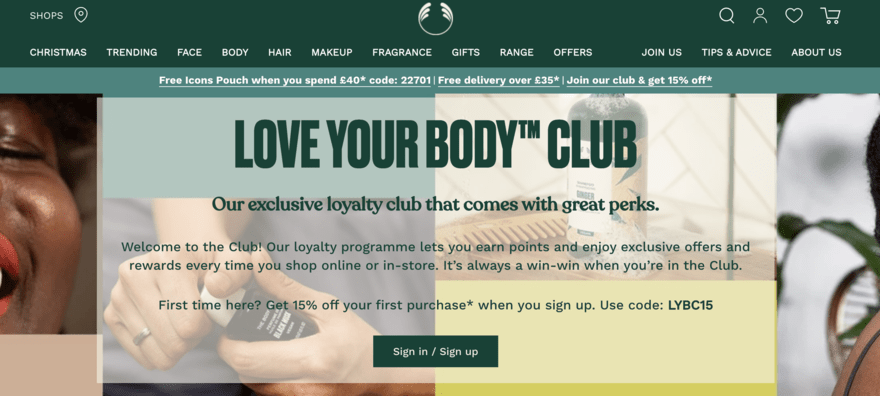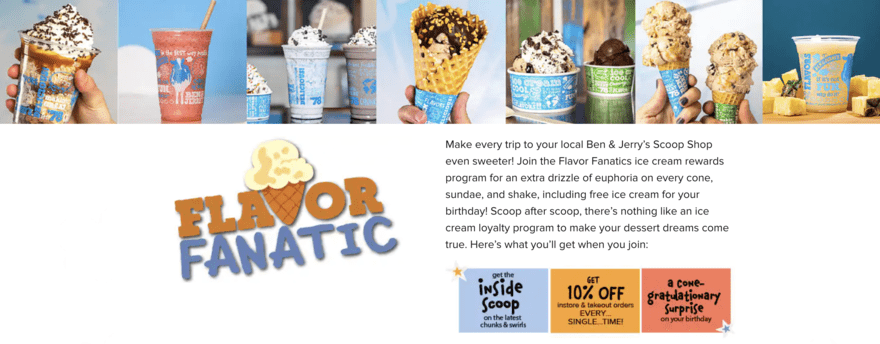8 Great Customer Loyalty Program Examples
If you click to purchase a product or service based on our independent recommendations and impartial reviews, we may receive a commission. Learn more
We all have our favorite brands, the ones we return to time and time again, but why do we keep going back?
Well firstly we clearly like the products or services they offer but it also means the brand has created a great experience through the customer lifecycle, which consists of five main stages; the final one being “loyalty.”
A customer loyalty program is a great way to encourage returning customers to your store. By providing customers with an incentive to shop with you, they’ll keep coming back for more.
Customer loyalty programs show that you value your customers choosing you over competitors.
If you’re thinking about setting up a program of your own, look no further than the eight customer loyalty program examples in this article to inspire you.
What Is a Customer Loyalty Program?
A customer loyalty program is a strategy put in place by brands to attract customers and encourage repeat business.
Repeat business will usually be encouraged through incentives such as offers, discounts, and rewards the more times a customer shops with a brand.
Customer loyalty programs allow brands to give back to loyal customers and help to build relationships and loyalty with their customer base.
How Do Customer Loyalty Programs Work?
Customer loyalty programs work by offering points or benefits to customers each time they shop with your brand. Customers can then exchange these points for rewards such as discounts, free products, or “insider” perks.
Each time a customer enrolled in the loyalty program shops with your brand, they’ll receive a benefit. This could be anything from a free product sample to free shipping on their next order or a discount code to refer a friend.
The more they shop with you, the more rewards they will earn.
Types of Customer Loyalty Programs
There are various types of customer loyalty programs and you can pick the one that you think will work best for both your brand and your customers.
Points-Based Loyalty Programs
Points-based loyalty programs are one of the most common custom loyalty program examples.
Customers will earn points every time they make a purchase from your online store that they can accumulate and then trade in for a reward once they reach a certain number of points.
Many brands also allow customers to earn points for other brand engagement activities such as sharing a post on social media or leaving you a customer review on your website.
Customers will be able to save up their points and exchange them for a reward, based on the number of points they have. For example, you may decide that 100 points = 10% off while 200 points = a free product with their next order.
Customers can then decide if they want to “cash in” their points when they get to 100 or keep saving up to 200 points. The more points a customer has the better the rewards usually are.
Tiered Loyalty Programs
Tiered customer loyalty programs reward customers based on the rank given to them by the brand.
For example, the more a customer shops and spends with a brand, the higher their rank will be.
Each tier or rank usually comes with its own set of benefits – for example tier one may offer free shipping on all orders, while tier two may offer free shipping and 10% off when you spend over $50.
A tiered system encourages customers to keep shopping from your online store so that they can move up to the next tier and reap the rewards.
Paid Loyalty Programs
A paid loyalty program requires customers to pay a fee to be part of the program, either a one-time or ongoing payment, that then gives them access to rewards.
For example, you may offer customers access to a loyalty membership where they pay $10 per month and receive free shipping on all orders and special discounts throughout the month.
Although it can be a little harder to encourage sign-ups to paid customer loyalty programs, the benefits for both the customer and your brand can be much greater.
Make sure the benefits outweigh the fee if you opt for a paid loyalty program. Make sure your customers can see the value of paying to be part of the program.
Value-Based Loyalty Programs
Value-based loyalty programs are used to form deeper connections with your customers.
Instead of rewarding customers for purchasing with you, each time they place an order you donate to a chosen charity.
For example, you may select a charity and determine that each time a customer signed up for the loyalty program places a purchase, you will donate 10% of their order value to the charity.
Another way for value-based loyalty programs to work is by donating similar products to those in need. For example, if you’re a clothing store that sells coats, you could donate one coat to a homeless shelter for every coat bought.
Although customers don’t receive a direct reward, they can shop with the knowledge that each purchase they make is helping someone else.
8 Great Customer Loyalty Programs
#1 Starbucks Rewards

Starbucks Rewards runs through a smartphone app which may be commonplace today, but back when Starbucks first launched the loyalty program, it was actually pretty revolutionary.
Running the rewards program through an app on customers’ phones means customers don’t need to remember to take a loyalty card with them every time they want a coffee fix.
In order to earn rewards, customers must scan the Starbucks app each time they make a purchase. Customers are able to build up points to get rewards.
They can also pay within the app to earn even more rewards. This means that not only is Starbucks benefitting from the incentive-based purchases, but they also have access to valuable customer data.
The use of an app like Starbucks’ is a great way to understand customer behavior and preferences. Starbucks is able to see order details, preferred store locations, menu favorites, etc, all by encouraging users to scan the app each time they buy a cup of coffee.
Starbucks is then able to use this information to provide personalized perks and rewards to customers.
#2 Sephora

Sephora’s Beauty Insider program is one of the most popular customer loyalty program examples. It’s estimated that it has over 25 million members worldwide.
The customer loyalty scheme follows a simple points-based system. Each time a customer makes a Sephora purchase, they earn points.
What makes Sephora’s Beauty Insider program stand out from the crowd, however, is that customers can decide how they use the points they’ve built up.
Beauty Insider users can redeem their points for an array of rewards such as discounts and special offers, to offset the price of a purchase, or even to access special edition products not available to non-loyalty customers.
This is a great way to personalize a loyalty scheme because customers are able to choose for themselves exactly what reward they want.
#3 The North Face

The North Face customer loyalty program is a great example of a personalized customer loyalty scheme.
Customers can earn points in the traditional way, by making purchases, as well as in more unique ways such as by attending The North Face events, downloading the brand’s app, using a reusable bag in-store, and even by checking in at certain locations.
What makes The North Face’s program so good is that how customers can use their points is totally personalized to their lifestyles.
For example, customers can opt to cash in their points in return for trying out new products before they’re released to the public or even towards a unique outdoor traveling experience.
The North Face loyalty program is a great example of the importance of connecting with your customers on a deeper level and understanding the rewards that will be of real value to them, and then finding unique ways to provide them to customers.
#4 Amazon Prime

Amazon Prime is one of the leading customer loyalty programs.
For a monthly fee, customers have access to free two-day shipping as well as other perks such as the Prime streaming service and special deals and discounts on “Prime Day”, an annual event of discounts across products for Prime members.
A loyalty program like Prime is essential for Amazon since the majority of the products it sells can be found elsewhere online – there are very few items on Amazon that are exclusive to the marketplace.
Amazon Prime, therefore, helps the brand to stay ahead of the competition and ensure customers choose to buy the item from them and not elsewhere.
A model like Amazon’s is a good example to follow for brands that have stiff competition from competitors selling similar products at similar prices. A loyalty scheme can help you stand out.
Similarly, opting for a paid loyalty program like Amazon Prime can in fact encourage more custom because customers are keen to get as much value out of their initial investment as possible and will therefore place more orders to reap the benefits.
#5 Uber

Uber Rewards is a great points-based customer loyalty program example.
Each time a customer uses Uber or UberEats, they’ll earn points. These points can then be added up and used to claim rewards such as Uber Cash, priority pick-up options, and flexible cancellations.
Uber Rewards combines this points-based system with a tiered system as the more points a customer racks up, the higher the tier they will be categorized as. The higher their membership level, the more benefits and rewards they will unlock.
The Uber Rewards program is particularly clever as the points a customer earns are used to provide a better customer experience, such as faster pick-ups or the chance to cancel your booking free of charge, meaning happier customers.
Essentially, the more a customer uses Uber and earns points, the better their experience will be.
#6 The Body Shop

The Body Shop is a beauty brand built on ethics so it’s perhaps no surprise that its loyalty program gives customers the chance to give back.
As part of the Love Your Body club, customers earn a point for every dollar they spend at The Body Shop. Once they’ve reached 100 points they’ll be given a reward of $10 to spend in-store. However, customers have the option to donate this $10 to a charity partner instead.
This is a great way of creating a loyalty program that’s in keeping with the brand’s ethos and values and encourages customers to shop more because they know once they’ve reached 100 points, they’ll be able to make a charity donation.
A loyalty program such as this is a great way to highlight to customers that your values align with theirs and that your sole focus isn’t just about making a profit.
#7 Barnes & Noble

The Barnes and Noble customer loyalty program is a great example of a paid scheme that provides enough value to customers to work.
To join the program and become a “VIP”customers have to pay an annual fee of $25.
In return for the fee, customers receive free shipping on all orders, 40% off hardcover bestsellers in-store, birthday offers, discounts, and early access to some new releases.
The rewards that customers receive are extensive and Barnes and Noble have ensured that the value far outweighs the annual membership fee.
The trick with a paid scheme like this is to focus on your existing customer base first. New customers aren’t likely to want to pay out to join a scheme for a brand they don’t yet know they like.
Existing customers, meanwhile, already know they like your brand, so by marketing your paid-for loyalty scheme to them, you have a much greater chance of getting sign-ups.
#8 Ben & Jerry’s

Signing up for the Ben & Jerry’s Flavor Fanatics reward scheme gives customers 10% off every purchase as well as other rewards such as free cones, discounts, and free ice cream on your birthday.
The customer loyalty program is simple yet effective – after all, Ben & Jerry’s remains one of the most popular ice cream brands in the world.
By offering such an array of rewards for customers, the brand cleverly encourages purchases without seeming pushy.
The brand also does a considerable amount of social impact work, offering flavors such as Save Our Swirled aimed at fighting climate change.
This, combined with the rewards on offer, provides customers with a great incentive to sign up and get shopping for their favorite flavors.
Customer Loyalty Programs: Summary
As you can see from these eight customer loyalty program examples, there are an array of ways that you can encourage repeat custom and build a loyal customer base through a rewards program.
Whether you want to emulate Amazon Prime with a paid-for membership style or decide to create a rewards app like Starbucks to really understand your customers’ shopping behavior, a customer loyalty program can provide an increase to your profits and a boost to your customer relations.
Let us know in the comments which of these customer loyalty program examples you found the most inspiring (and if you’re a member of any of them yourself!) and be sure to check out our article on how to sell online for more tips and tricks to make your ecommerce brand a success.

Leave a comment